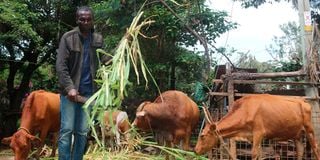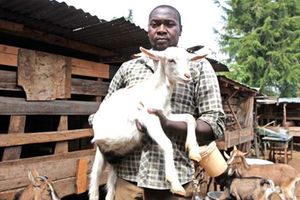
Sammy Kariuki, a former journalist-turned-dairy farmer, chops Juncao grass for his cows at his farm in Lengenet, Rongai, Nakuru.
When Sammy Kariuki took the decision to put down the microphone, agriculture was one of his most promising alternatives. Kariuki had been a journalist for more than 20 years.
“I always had a passion for dairy farming,” Kariuki says, adding that he is also into poultry and sheep farming.
Initially, the milk he produced was mainly for subsistence. He went commercial a few years ago.
However, the rising cost of feed made it difficult to realise profits. To make matters worse, the feed he bought was sub-standard.
Kariuki relied on Napier grass and maize stalks.
“The most amount of milk a cow could produce in a day was five litres,” he says.
From a TV programme on reducing production costs, Kariuki learnt of a new grass.
“Juncao is a modern feed that has drastically reduced costs,” he says.
“After watching the programme, I did some research online and discovered the nutrient-rich grass is easy to produce.”
Juncao grass has been in use in by dairy farmers China for many years. The grass can be grown as fodder for animals and a substrate for mushrooms for human consumption.
The lush tall and succulent grass was developed by Lin Zhanxi, a professor at Fujian Agriculture and Forestry University, China, in the 1980s.
Juncao technology can improve crop and livestock production, thereby helping alleviate poverty, create jobs and restore degraded environments.
“From the time I started using the grass in 2022, I have seen a remarkable change in my agribusiness,” Kariuki says at his farm in Lengenet, Nakuru County.
Juncao grass is planted on the edges of his compound. With seven milking cows and some bulls, Kariuki has dedicated an acre to the grass.
He recently acquired an additional acre for Juncao.
“Every cow yields 12 to 15 litres of milk a day,” he says.
Kariuki sources cuttings from Juncao Grass Technology Kenya, a farm in Kampi ya Moto.
Established in 2021, the firm has a 50-acre Juncao grass plantation, with similar projects in Lodwar, Garissa and Makueni counties.
Kenya has in recent years experienced a deficit in animal feed, importing more than 80 per cent of feed raw materials.
The situation was exacerbated by the Covid-19 pandemic in 2020 and high taxes on imports.
Soybean, corn, wheat bran, maize germ, cotton seed cake and barley are among the crucial raw materials for feed.
Juncao Grass Technology Kenya’s Project Manager, Edwin Wekesa, says the company is keen on providing affordable fodder rich in minerals.
“This grass is high-yielding and contains crude protein, estimated at 18.6 per cent,” Wekesa says.
Apart from feeding cows and growing mushrooms, it can be processed into fish pellets, poultry, goat and sheep feed. It also makes silage.
“The grass does not require supplements or additives like molasses,” Wekesa says.
Juncao is part of climate-smart agriculture. It was initially meant to combat desertification and soil erosion.
It is also used to produce biomass, a renewable organic material that comes from plants and animals and can be burnt directly for heat or converted to liquid and gaseous fuels.
“It is a drought-tolerant and resilient grass,” Wekesa says, adding that managing it is not labour-intensive.
To plant it, one needs Juncao stalk cuttings. Kariuki digs 10cm deep holes, spaced at 1.5 to 2.0 metres between rows and similar measurements between plants.
“The best cutting stem should have two nodes and internodes,” he says, adding that he uses animal manure.
Seedlings can be propagated in a nursery before being transplanted to the field.
He has not encountered pest and diseases. Juncao can grow as tall as seven metres, though the height ranges between four to five metres. The diameter of the stem is 1.5 to 2.5cm.
With good management, the grass matures three months after planting. Wekesa says an acre can produce 180 tonnes a year.
He says Juncao Grass Technology Kenya has supplied at least 1,000 farmers with hybrid grass cuttings through groups and cooperatives.
“We have created more than 500 direct jobs,” he says.






